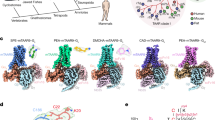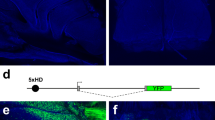Abstract
In addition to their role in the immune response, peptide ligands of major histocompatibility complex (MHC) molecules function as olfactory cues for subsets of vomeronasal sensory neurons (VSNs) in the mammalian nose. How MHC peptide diversity is recognized and encoded by these cells is unclear. We found that mouse VSNs expressing the vomeronasal receptor gene V2r1b (also known as Vmn2r26) detected MHC peptides at subpicomolar concentrations and exhibited combinatorial activation with overlapping specificities. In a given cell, peptide responsiveness was broad, but highly specific; peptides differing by a single amino-acid residue could be distinguished. Cells transcribing a V2r1b locus that has been disrupted by gene targeting no longer showed such peptide responses. Our results reveal fundamental parameters governing the response to MHC peptides by VSNs. We suggest that the peptide presentation system provided by MHC molecules co-evolves with the peptide recognition systems expressed by T cells and VSNs.
This is a preview of subscription content, access via your institution
Access options
Subscribe to this journal
Receive 12 print issues and online access
$209.00 per year
only $17.42 per issue
Buy this article
- Purchase on Springer Link
- Instant access to full article PDF
Prices may be subject to local taxes which are calculated during checkout







Similar content being viewed by others
References
Davis, M.M. et al. T cells as a self-referential, sensory organ. Annu. Rev. Immunol. 25, 681–695 (2007).
Cooper, M.D. & Alder, M.N. The evolution of adaptive immune systems. Cell 124, 815–822 (2006).
Davis, M.M. & Bjorkman, P.J. T-cell antigen receptor genes and T-cell recognition. Nature 334, 395–402 (1988).
Eason, D.D. et al. Mechanisms of antigen receptor evolution. Semin. Immunol. 16, 215–226 (2004).
Huh, G.S. et al. Functional requirement for class I MHC in CNS development and plasticity. Science 290, 2155–2159 (2000).
McConnell, M.J., Huang, Y.H., Datwani, A. & Shatz, C.J. H2-Kb and H2-Db regulate cerebellar long-term depression and limit motor learning. Proc. Natl. Acad. Sci. USA 106, 6784–6789 (2009).
Leinders-Zufall, T. et al. MHC class I peptides as chemosensory signals in the vomeronasal organ. Science 306, 1033–1037 (2004).
He, J., Ma, L., Kim, S., Nakai, J. & Yu, C.R. Encoding gender and individual information in the mouse vomeronasal organ. Science 320, 535–538 (2008).
Spehr, M. et al. Essential role of the main olfactory system in social recognition of major histocompatibility complex peptide ligands. J. Neurosci. 26, 1961–1970 (2006).
Boehm, T. Quality control in self/nonself discrimination. Cell 125, 845–858 (2006).
Brennan, P.A. & Zufall, F. Pheromonal communication in vertebrates. Nature 444, 308–315 (2006).
Rammensee, H.G., Bachmann, J. & Stefanovic, S. MHC Ligands and Peptide Motifs, (Landes Bioscience, Georgetown, TX, 1997).
Herrada, G. & Dulac, C. A novel family of putative pheromone receptors in mammals with a topographically organized and sexually dimorphic distribution. Cell 90, 763–773 (1997).
Matsunami, H. & Buck, L.B. A multigene family encoding a diverse array of putative pheromone receptors in mammals. Cell 90, 775–784 (1997).
Ryba, N.J. & Tirindelli, R. A new multigene family of putative pheromone receptors. Neuron 19, 371–379 (1997).
Young, J.M. & Trask, B.J. V2R gene families degenerated in primates, dog and cow, but expanded in opossum. Trends Genet. 23, 212–215 (2007).
Silvotti, L., Moiani, A., Gatti, R. & Tirindelli, R. Combinatorial co-expression of pheromone receptors, V2Rs. J. Neurochem. 103, 1753–1763 (2007).
Grus, W.E. & Zhang, J. Origin of the genetic components of the vomeronasal system in the common ancestor of all extant vertebrates. Mol. Biol. Evol. 26, 407–419 (2009).
Del Punta, K., Puche, A., Adams, N.C., Rodriguez, I. & Mombaerts, P. A divergent pattern of sensory axonal projections is rendered convergent by second-order neurons in the accessory olfactory bulb. Neuron 35, 1057–1066 (2002).
Leinders-Zufall, T. et al. Ultrasensitive pheromone detection by mammalian vomeronasal neurons. Nature 405, 792–796 (2000).
Spehr, J. et al. Ca2+-calmodulin feedback mediates sensory adaptation and inhibits pheromone-sensitive ion channels in the vomeronasal organ. J. Neurosci. 29, 2125–2135 (2009).
Ukhanov, K., Leinders-Zufall, T. & Zufall, F. Patch-clamp analysis of gene-targeted vomeronasal neurons expressing a defined V1r or V2r receptor: ionic mechanisms underlying persistent firing. J. Neurophysiol. 98, 2357–2369 (2007).
Ishii, T. & Mombaerts, P. Expression of nonclassical class I major histocompatibility genes defines a tripartite organization of the mouse vomeronasal system. J. Neurosci. 28, 2332–2341 (2008).
Lucas, P., Ukhanov, K., Leinders-Zufall, T. & Zufall, F. A diacylglycerol-gated cation channel in vomeronasal neuron dendrites is impaired in TRPC2 mutant mice: Mechanism of pheromone transduction. Neuron 40, 551–561 (2003).
Boehm, T. & Zufall, F. MHC peptides and the sensory evaluation of genotype. Trends Neurosci. 29, 100–107 (2006).
Bozza, T., Feinstein, P., Zheng, C. & Mombaerts, P. Odorant receptor expression defines functional units in the mouse olfactory system. J. Neurosci. 22, 3033–3043 (2002).
Feinstein, P., Bozza, T., Rodriguez, I., Vassalli, A. & Mombaerts, P. Axon guidance of mouse olfactory sensory neurons by odorant receptors and the beta2 adrenergic receptor. Cell 117, 833–846 (2004).
Grosmaitre, X., Vassalli, A., Mombaerts, P., Shepherd, G.M. & Ma, M. Odorant responses of olfactory sensory neurons expressing the odorant receptor MOR23: a patch clamp analysis in gene-targeted mice. Proc. Natl. Acad. Sci. USA 103, 1970–1975 (2006).
Mombaerts, P. Genes and ligands for odorant, vomeronasal and taste receptors. Nat. Rev. Neurosci. 5, 263–278 (2004).
Boschat, C. et al. Pheromone detection mediated by a V1r vomeronasal receptor. Nat. Neurosci. 5, 1261–1262 (2002).
Malnic, B., Hirono, J., Sato, T. & Buck, L.B. Combinatorial receptor codes for odors. Cell 96, 713–723 (1999).
Firestein, S. How the olfactory system makes sense of scents. Nature 413, 211–218 (2001).
Luo, M. & Katz, L.C. Encoding pheromonal signals in the mammalian vomeronasal system. Curr. Opin. Neurobiol. 14, 428–434 (2004).
Chandrashekar, J., Hoon, M.A., Ryba, N.J. & Zuker, C.S. The receptors and cells for mammalian taste. Nature 444, 288–294 (2006).
Slev, P.R., Nelson, A.C. & Potts, W.K. Sensory neurons with MHC-like peptide binding properties: disease consequences. Curr. Opin. Immunol. 18, 608–616 (2006).
Mouritsen, S., Meldal, M., Werdelin, O., Hansen, A.S. & Buus, S. MHC molecules protect T cell epitopes against proteolytic destruction. J. Immunol. 149, 1987–1993 (1992).
Milinski, M. The major histocompatibility complex, sexual selection, and mate choice. Annu. Rev. Ecol. Evol. Syst. 37, 159–186 (2006).
Marrack, P., Scott-Browne, J.P., Dai, S., Gapin, L. & Kappler, J.W. Evolutionarily conserved amino acids that control TCR-MHC interaction. Annu. Rev. Immunol. 26, 171–203 (2008).
Garcia, K.C., Adams, J.J., Feng, D. & Ely, L.K. The molecular basis of TCR germline bias for MHC is surprisingly simple. Nat. Immunol. 10, 143–147 (2009).
Krogsgaard, M., Juang, J. & Davis, M.M. A role for “self” in T-cell activation. Semin. Immunol. 19, 236–244 (2007).
Wucherpfennig, K.W. The structural interactions between T cell receptors and MHC-peptide complexes place physical limits on self-nonself discrimination. Curr. Top. Microbiol. Immunol. 296, 19–37 (2005).
Padovan, E. et al. Expression of two T cell receptor alpha chains: dual receptor T cells. Science 262, 422–424 (1993).
Mombaerts, P. et al. Visualizing an olfactory sensory map. Cell 87, 675–686 (1996).
Acknowledgements
We thank M. Konzmann for excellent technical assistance, R. Escher for peptide synthesis, K. Del Punta for a backbone plasmid of the gene targeting vector, W. Tang for blastocyst injections of ES cells and B. Bufe for comments and discussion. This work was supported by the Volkswagen Foundation (T.L.-Z.), Deutsche Forschungsgemeinschaft grants Sonderforschungsbereich 530 (F.Z.) and Schwerpunktprogramm 1392 (F.Z. and P.M.), the Max Planck Society (T.I., P.M. and T.B.), and the US National Institutes of Health (F.Z. and P.M.).
Author information
Authors and Affiliations
Contributions
T.L.-Z., T.I., P.M., F.Z. and T.B. designed the study. T.L.-Z. and T.I. carried out the experiments. T.L.-Z., T.I., P.M., F.Z. and T.B. analyzed the data. T.L.-Z., T.I., P.M., F.Z. and T.B. contributed reagents and analytic tools. T.L.-Z., P.M., F.Z. and T.B. wrote the paper.
Corresponding authors
Supplementary information
Supplementary Text and Figures
Supplementary Figures 1–4 and Supplementary Tables 1–3 (PDF 3752 kb)
Rights and permissions
About this article
Cite this article
Leinders-Zufall, T., Ishii, T., Mombaerts, P. et al. Structural requirements for the activation of vomeronasal sensory neurons by MHC peptides. Nat Neurosci 12, 1551–1558 (2009). https://doi.org/10.1038/nn.2452
Received:
Accepted:
Published:
Issue Date:
DOI: https://doi.org/10.1038/nn.2452
This article is cited by
-
Coding of pheromones by vomeronasal receptors
Cell and Tissue Research (2021)
-
Bacterial MgrB peptide activates chemoreceptor Fpr3 in mouse accessory olfactory system and drives avoidance behaviour
Nature Communications (2019)
-
Type 3 inositol 1,4,5-trisphosphate receptor is dispensable for sensory activation of the mammalian vomeronasal organ
Scientific Reports (2017)
-
Influence of HLA on human partnership and sexual satisfaction
Scientific Reports (2016)
-
Genome-wide association analysis on five isolated populations identifies variants of the HLA-DOA gene associated with white wine liking
European Journal of Human Genetics (2015)



